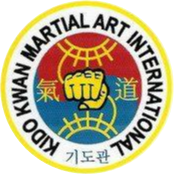The history of Chung Do Kwan 청도관 靑濤館, its founder, leaders, black belts, and their legacy represent one of the most significant Korean exports to the world. Numerous leaders in Korean Taekwon-Do and martial arts emerged from Chung Do Kwan or were directly influenced by its members.
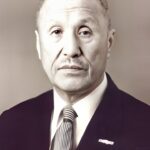
It is essential to discuss the founder of the Chung Do Kwan, Lee Won-kuk (이원국; 李元國). Born in Seoul, Korea (historically known as Hanseong) on April 13, 1907, LEE’S birth coincided with a pivotal time in Korea’s history. During this period, the Japanese Empire had already established its influence over Korea, which began decades earlier in 1876 with the Japan-Korea Treaty of 1876. However, it was in 1905 that Japan formalized its control over Korea through the Japan-Korea Treaty of 1905.
Thus, LEE was born a citizen of the Japanese Empire, as the official name of Korea in 1907 was Joseon (Chosen in Japanese) and was ruled by King Gojong until his forced abdication by Japan on July 19th of 1907. LEE was just a few months old when Korea lost its last true sovereign. The Japan–Korea Treaty of 1910, also known as the “Japan–Korea Annexation Treaty”, on 22 August 1910, formalized Japan’s annexation of Korea.
In June of 1926, LEE traveled to Tokyo to complete high school and enter the Japanese Imperial University system. Before his journey to Japan, he attended the Keijo Imperial University, founded in 1924. For the first two years, students were enrolled only in the preparatory education division (予科), which was similar to the High Schools in mainland Japan, except it was a year shorter and included Japanese language instruction for Korean students, as most faculty members were Japanese. When the first group of students completed their preparatory education in 1926, three-year programs for law and literature were introduced, along with a four-year medical program. Keijo was established as a direct result of the March 1st Movement (Sam-Il) of 1919.
LEE chose the law program and further pursued his education at Chou University in Tokyo, which became a new degree-issuing university under the Japanese Imperial University Ordinance of 1918. LEE and many others who followed him were able to study in Japan under what was known as the Government General of Chosen Scholarships (GGC).
During his stay in Japan, Korean students were encouraged to embrace all things Japanese. One of the newest physical fads in Tokyo at the time was the emergence of martial arts, particularly Karate from Okinawa. LEE initially took up western boxing, but after a few weeks and sustaining injuries, he sought a less brutal form of physical exercise.
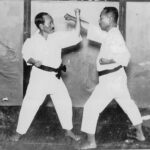
Prior to 1926, the term Kara-Te唐手 was pronounced the same as the modern version, but with the Kanji for Tang (China) Hand versus Kara-Te空手 (Empty Hand), which was used until 1929. The main reason for the change in Kanji (hanja in Korean) was that Funakoshi Gichin (founder of modern Japanese Karate-Do called Shoto-Kan) understood that under the Imperial Government of Japan, the more Japanese Kanji would help spread his art than the older Okinawan/Chinese Kanji meaning “China Hand.” Since LEE first used the term Tang Soo meaning China Hand versus the newer Empty Hand, it strongly suggests that LEE’S training began shortly after he arrived in Japan, as he retained the name Tang Soo until the Second Kwan Jang (school leader) SON, Duk-sung changed it to “Tae Kwon Do” after 1955 within the Chung Do Kwan. It has been written and implied that LEE learned Shotokan Karate while at Chou University; however, Karate wasn’t taught there until after World War II, according to the University. Nevertheless, FUNAKOSHI had a significant presence in Tokyo and within YMCA’s, government schools, and buildings, especially because he introduced Karate to mainland Japan from Okinawa in 1917 and 1922, primarily spread by Kodokan Judo instructors, and his son Gigo, who was the third son of FUNAKOSHI. It was Gigo in 1923 who influenced Shotokan more in mainstream Japan and later Chung Do Kwan, and other future Korean Kwan leaders, as it is more likely that LEE trained under him while in Tokyo.
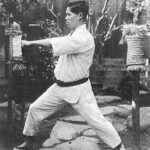
According to Kimm 2013, LEE trained within the Shotokan system under FUNAKOSHI for five years, earning the rank of 4th dan (degree of black belt). At the time, the highest dan rank was 5th dan. However, LEE stated that he had been training for almost 4 years before achieving 1st dan and subsequently earned every other dan rank about a year apart. He recalled meeting RO, Byung-jik, around 1936. The first time dan ranks in Shotokan Karate were issued in 1924! FUNAKOSHI awarded five students their 1st dan in 1924. In 1924, the ranks available were 8th, 7th, 6th, 5th, and 4th kyu (keub in Korean) white belt, and 3rd, 2nd, 1st kyu brown belt, and until the 1950s, 1st to 5th dan.
LEE returned to Korea in late 1942, having spent 16 years in Japanese-held territories. In a personal interview with me in 1999, he recounted that after obtaining his Law Degree (English Law) from Chou University, he had to repay for the privilege, which was a requirement during the Japanese occupation. Since Korea had nearly no significant employment opportunities, Koreans migrated to Japan and other Japanese colonies to find employment. LEE indicated that he wouldn’t have been granted any further opportunities because of his education. He mentioned working for the Japanese Government in Manchuria and making two government trips to Okinawa as a Japanese and Korean translator. His work in Manchuria also involved assisting the Japanese Government on the South Manchuria Railway and utilizing his law and translation skills for Japanese officials and the Korean workers predominantly employed in Manchuria for the Japanese Government. This is the same railway that the founder of the Moo Duk Kwan, HWANG Kee, also worked on.
LEE stated that he worked for the GGC in Seoul, primarily doing translation work for the Gyeongbuseon (Railroad), which operated from Seoul to Busan, and where HWANG Kee worked after returning to Korea from Manchuria. LEE first sought to teach Tang Soo (Kara-Te or China Hand) in 1943 to supplement his meager earnings, as Koreans working for the GGC earned very little. According to LEE, he earned about 3 Korean Yen a day working 6 days a week, totaling 18 Korean yen per week. In USD at that time, this amounted to approximately .25 cents a day or about $1.50 a week! In today’s dollars, that is about $27.25 USD. Thus, his primary motivation was to supplement his income, as he had a family, and $1.50 a week was insufficient in the WW2 era Korea, or anywhere for that matter.
LEE mentioned that he requested to teach at least twice in 1943 and early 1944 and was finally granted approval, but he had to submit to the oversight of the Japanese Police Force, the Kempei keisatsu. According to SON, this would later contribute to LEE’S exile to Japan after the start of the Korean War.
According to LEE, he received approval to teach Tang Soo in February 1944 and began teaching within a month after securing a space to establish a dojang (also known as a dojo in Japanese). There is a long-standing misconception that martial arts were forbidden during the Japanese occupation of Korea. While boxing, Judo, jujutsu, Aikido, and Kendo schools existed throughout Japanese-occupied areas, what wasn’t ‘officially’ allowed were unsanctioned martial arts, or non-Japanese arts without Japanese influence. Two other Korean Kwans were permitted to open concurrently with LEE’S Chung Do Kwan, one being the Song Moo Kwan under RO, Byung-jik (SongMoo 松武), where Song means Pine and is the Korean pronunciation of Shoto (as in FUNAKOSHI’S Shotokan Karate). He likely chose to use the Korean pronunciation for Karate (empty hand 空手) of Kong Soo 공수, as he knew that LEE had a harder time getting “Tang Soo” approved, but Kong Soo should be much easier, and clearly, RO received his approval on the first attempt.
RO states that he first began teaching in March of 1944. LEE recalled that it was when he was allowed to open a dojang, but it was later in the year, around the same time that LEE moved his school from its initial location to where he established his second dojang around September of 1944. RO was twelve years younger than LEE. The first dojang location for LEE was a “carry over” of his teaching and learning at the YMCAs in Japan, where he first started teaching at An Kuk Dong in Seoul, which is a historic Christian Church. The church has played a pivotal role in the development of Christianity in Korea, serving as the headquarters for several early publications and the Trilingual Press. The Church is called Chungdong First Methodist Church (정동제일교회 貞洞第一敎會).
According to Professor SEO, SEOUNG-WONG, he presented in April of 2024 a lecture about the founding of the Chung Do Kwan. SEO is a Taekwondo researcher who is part of the Taekwondo Research Association (of which I am one of two Americans at present). His lecture titled “The History of Taekwondo as seen through the media 1944 to Present,” where he found some “conflicting” news media about the founding of the Chung Do Kwan. Several key things to remember before I present his findings. The media during the early 20th century wasn’t what we have today. Today, we can usually come to our internet-connected device, and have access to billions of records at the stroke of a few keys, that’s how you got here! But, in the early 20th century, would would have to physically go from one town to the next and comb through the local news agency office (if they had one) so, when new locations opened, or a new event happened in one place, other places may not be aware of similar or same things done intheir locations. Now, I know those my age and older will recall that, but even my oldest son, who is currently 28, has a hard time understanding a world without easy access to information!
SEO in his lecture has found several interesting newspaper articles stating that the Chung Do Kwan was founded much later than the spring of 1944 timeframe that LEE, SON, and even CHOI and others have stated. One source, the KyungSung Il Bo 경성일보, had published an article that states the Chung Do Kwan was founded on August 11, 1945!
When I spoke to LEE about this, it was over 50 years after the fact, and KIMM likely had a more local source of information, but either way, LEE clearly started to teach in 1944, and used the term Chung Do Kwan Tangsoodo in 1944 or a bit later in February of 1946. Both are likely to have happened in one version or the other. But LEE did tell me he never used Kong Soo, but Tang Soo. Several interviews with LEE over the years have indicated that LEE came up with the name “Chung Do” while sitting on a beach and watching the blue waves crash in. While I have no doubt LEE hadn’t witnessed blue waves crashing on the shoreline, I believe that’s the romantic side of history that is not political, and nearly everything involving the early days of the Chung Do Kwan was ALL POLITICAL!
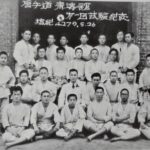
LEE was offered by the RHEE government as head instructor of the National Police Academy in Seoul in 1948. Many Chung Do Kwan members have said that Chung Do Kwan was considered the “Police Kwan”. So, LEE clearly held at least a minor government position, and according to KIMM in his 2013 publication, held what was considered the rank of a Colonel in the Provincial Korean government police organization. This was headed by an American, Lewis J. Valentine, the former New York City Police Commissioner, at the request of his friend, General Douglas MacArthur.
The 2nd Kwang Jang (관장님/館范), the title Kwang Jang means manager or hall chief. So, the
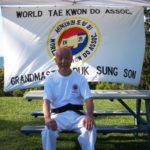
head of the school has morphed into the head of the style of Tangsoodo/Taekwondo. The 2nd Head was SON, Duk-sung. SON was one of the first generation of students of Chung Do Kwan. When I interviewed SON in 2002, he told me personally that he was about the 5th or 6th student to join the Chung Do Kwan in 1944. He never mentioned a break in training or that the Kwan closed at the end of WW2. But to be fair, I didn’t ask. It would make sense that most things kind of took a break when the Japanese Empire left Korea, aka kicked out by both the Soviet Government, which came south and occupied areas around Pyongyang and northward, and the US came in from Japan at Busan and set up in Seoul at the end of the War. SON was born June 17, 1922, so he was 15 years junior to LEE.
SON became the Kwang Jang of the Chung Do Kwan according to SON in 1950. So that means LEE was only the head of Kwan from 1944 to 1950, a total of six years, or again, if we follow KIMM, He-youngs timeline from 1946 to 1950, a total of 4 years (in name that is). About 1938, SON took up western boxing at a local YMCA. The YMCA will play a huge role in the Korean Martial Arts scene prior to the end of WW2 and after. The YMCAs played a pivotal role in much of Korean politics in the early 20th Century as well!
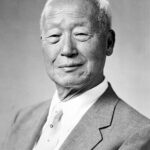
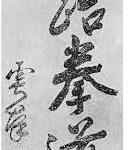
According to him (SON), he became the Kwang Jang in 1951. This was shortly after the start of the Korean War when North Korea under the leadership of KIM, IL-sung with the support of the Soviet Union and Communist China invaded from the north of the 38th Parallel which was oddly enough, picked as the dividing line to keep USA and Soviet Union separate in Korea, by two American Army officers off of a National Geographic Map at the end of WW2! LEE, because of his long involvement with the Japanese Government of Korea, fled to Japan. According to LEE, he was arrested by the RHEE, Syang-man (President of Republic of Korea) government prior to the Korean War, and was released about 3 months before, and first fled with SON to Busan during the invasion and then took a ferry from Busan (South Korea) to Shimonoseki (Japan). LEE remained in Japan until 1968, when he was “allowed” to return to Korea after the RHEE regime was ultimately replaced by the PARK, Chung-Hee administration. Then LEE immigrated to the USA at the request of RHEE, Joon-goo. Known as “Jhoon Rhee” in the USA, he will be discussed a bit later.

SON became the 2nd Kwang Jang after LEE initially asked CHOI, HONG-HI to replace him in 1951 when CHOI was at the military officer’s school in Busan at the time. CHOI had also studied Shotokan in Japan as a student in Tokyo as well, and was a founding member of the Korean Constabulary, which, after the invasion from the North, became the Republic of Korea Army in 1951. Since CHOI was a military officer, he was barred from holding any civilian positions and thus could not take charge of the Chung Do Kwan as LEE had hoped. So, CHOI had suggested that LEE appoint SON, who was with him in Busan, to take charge of the Chung Do Kwan, and LEE agreed as SON was one of his seniors in 1951, having been with him since 1944/1945. At this time when SON took over the Chung Do Kwan, he “appointed” CHOI as a co-director in name as his hope was since CHOI who was in the military he would be able to help and protect the Chung Do Kwan during the time of the upheaval of the conflict with “North Korea.”
Since SON was now the 2nd Kwang Jang, he would automatically take on the rank of 5th dan. When I asked SON when he was promoted to 5th dan, he claimed it was before the outbreak of the Korean War. However, this isn’t likely, but it was over 40 years ago, and to be fair, I don’t recall what I had for breakfast yesterday, so time can and does affect our memories! And according to SON, “I promoted CHOI to the rank of 4th dan in the Chung Do Kwan”, one rank below the Kwang Jang, SON and LEE. “He was only a 3rd dan in Karate, and we already started to look more like Taekwondo and less Karate-like.”
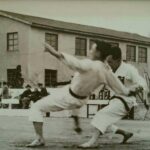
SON remained as Kwang Jang from 1951 until 1959 before he was “replaced” by one of his juniors, UHM Woon-kyu, who, according to KANG, Won-sik and LEE, Kyong-myong and their work “A Modern History of Taekwondo,” was the 3rd Chung Do Kwan black belt under LEE, with YOO, Ung-jun being the 1st to get his black belt from LEE and SON Duk-sung the second! SON left Korea in 1959 in part for a better opportunity but also because the politics of the day pushed him out. SON started to butt heads early on with other kwan members. One being UHM, who was the 4th black belt promoted by LEE, and one of the biggest threats he faced may have been Chung Do Kwan #10 black belt, who was NAM, Tae-hi. He was also active-duty Army with the South Korean Armed Forces, and was appointed by CHOI, Hong-hi as his #2 in the Tangsoo/Taekwon world. Having formed the Oh Do Kwan within the Army and placed NAM as its first leader.
PART TWO (2) COMING SOON!
![]()
